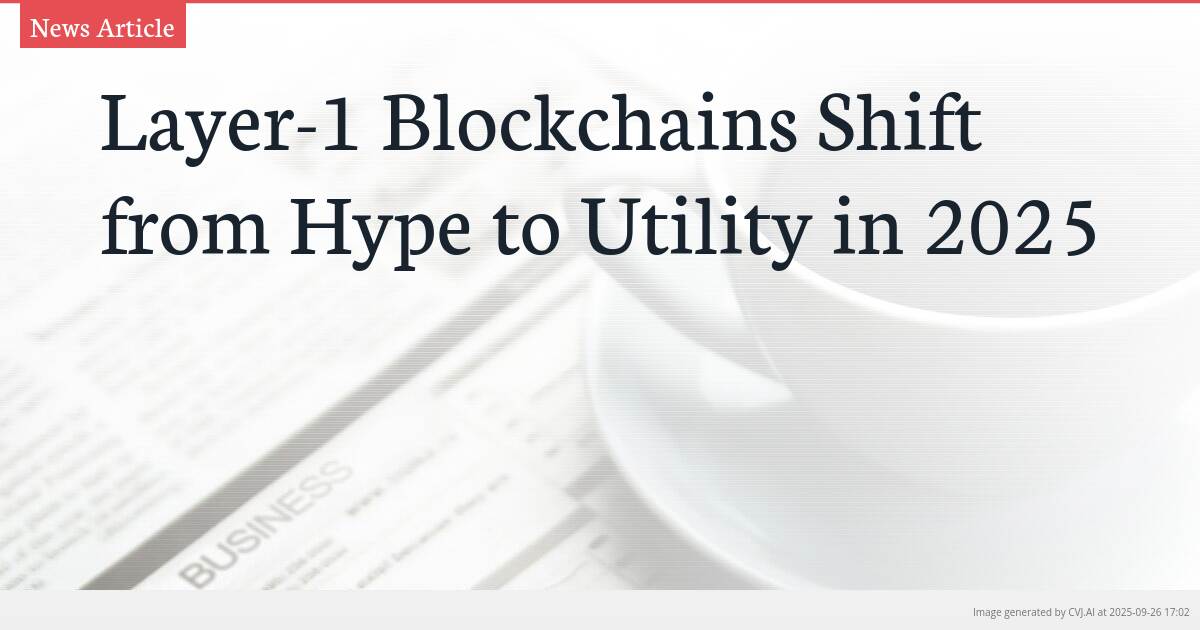This summary text is fully AI-generated and may therefore contain errors or be incomplete.
Introduction
The cryptocurrency industry is undergoing a fundamental transformation in 2025, moving decisively beyond speculative hype toward tangible utility. As stablecoin frameworks mature and tokenized assets enter mainstream markets, layer-1 blockchains are emerging as the critical infrastructure enabling this seismic shift. With artificial intelligence beginning to transact on-chain, these foundational networks are being redefined not as experiments but as essential infrastructure powering real-world economic activities, marking a pivotal moment in blockchain’s maturation.
Key Points
- Stablecoin regulatory frameworks are maturing globally, providing clearer guidelines for adoption
- Tokenized traditional assets are entering mainstream financial markets through blockchain infrastructure
- Artificial intelligence systems are beginning to autonomously conduct transactions on blockchain networks
The Backbone of a Maturing Ecosystem
The narrative surrounding blockchain technology is shifting dramatically in 2025, with layer-1 protocols at the center of this evolution. According to Marc Vanlerberghe, chief strategy and marketing officer at the Algorand Foundation, “Layer-1s are still the backbone of the industry.” This sentiment, expressed on Cointelegraph’s Decentralize podcast, underscores a critical industry realization: these foundational networks are being tested and proven through real-world applications rather than theoretical potential. The transition from experimental technology to essential infrastructure represents a maturation milestone that validates the entire crypto ecosystem’s staying power.
This evolution is particularly significant given the historical focus on layer-1 performance metrics like transactions per second and theoretical scalability. Today, the conversation has shifted to practical utility, with networks like Algorand (ALGO) positioning themselves as reliable infrastructure for financial applications. The industry’s foundation is no longer being built on promises but on demonstrated capacity to support meaningful economic activity. This shift reflects growing confidence among institutional participants who require robust, predictable infrastructure before committing significant resources to blockchain-based solutions.
Stablecoins and Tokenization: Driving Real-World Adoption
The maturation of stablecoin regulatory frameworks represents perhaps the most significant driver of layer-1 utility in 2025. As governments worldwide establish clearer guidelines, stablecoins are transitioning from speculative trading instruments to legitimate payment mechanisms and value storage solutions. This regulatory clarity enables layer-1 blockchains to serve as settlement layers for transactions that were previously confined to traditional financial systems. The development creates new use cases that extend far beyond cryptocurrency trading, including cross-border payments, remittances, and programmable money applications.
Simultaneously, the emergence of tokenized traditional assets is creating unprecedented demand for reliable blockchain infrastructure. Real-world assets including bonds, equities, and real estate are increasingly being represented on-chain, requiring layer-1 networks that can guarantee security, transparency, and regulatory compliance. This tokenization wave brings traditional finance onto blockchain infrastructure, creating hybrid systems that leverage the efficiency of distributed ledger technology while maintaining connections to established financial markets. The Algorand Foundation and similar organizations are positioning their networks as ideal platforms for this convergence, emphasizing features like finality, low transaction costs, and regulatory compatibility.
AI and Autonomous On-Chain Transactions
Perhaps the most forward-looking development testing layer-1 infrastructure involves artificial intelligence systems beginning to conduct autonomous transactions on blockchain networks. This emerging trend represents a significant expansion of blockchain utility beyond human-operated applications. AI agents transacting on-chain require networks capable of handling complex, automated interactions with guaranteed execution and settlement. This application stresses layer-1 capabilities in new ways, demanding not just scalability but also predictability and reliability for machine-to-machine economic activity.
The integration of AI with blockchain through layer-1 infrastructure creates possibilities for decentralized autonomous organizations, automated market makers, and complex financial instruments that operate without human intervention. As Marc Vanlerberghe’s comments suggest, this evolution redefines layer-1 blockchains as critical infrastructure for next-generation economic systems rather than merely platforms for cryptocurrency transactions. The ability to support AI-driven economic activity represents a ultimate test of a blockchain’s utility and staying power, separating networks built for speculation from those designed for long-term viability.
Redefining Infrastructure for Mainstream Integration
The collective impact of these developments—stablecoin regulation, asset tokenization, and AI integration—is redefining how layer-1 blockchains are perceived and utilized. No longer viewed as experimental platforms, networks like Algorand are being positioned as essential financial infrastructure comparable to traditional payment rails and settlement systems. This shift in perception is crucial for broader adoption, as it enables traditional financial institutions to engage with blockchain technology with greater confidence and regulatory comfort.
The progression from hype to utility represents a natural maturation process for any disruptive technology. For layer-1 blockchains, 2025 appears to be the year this transition accelerates dramatically. As the Algorand Foundation’s perspective illustrates, the industry’s backbone is strengthening not through theoretical improvements but through practical applications that solve real-world problems. This utility-focused evolution suggests that blockchain technology may finally be reaching the inflection point where its promised benefits become accessible and valuable beyond the crypto-native community, potentially unlocking the next phase of global financial innovation.
📎 Read the original article on cointelegraph.com

